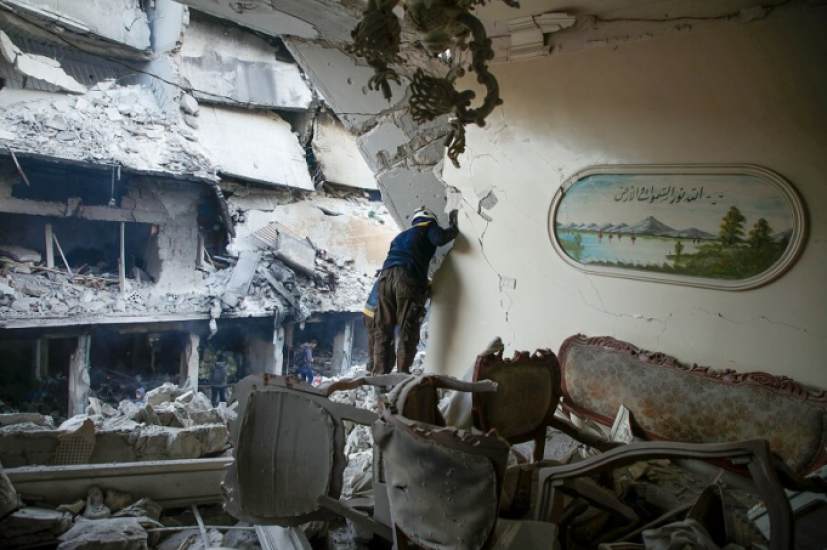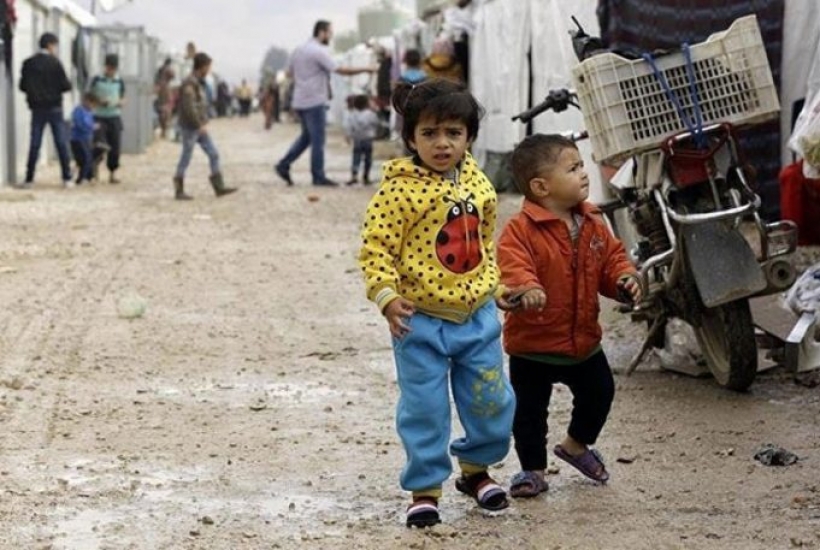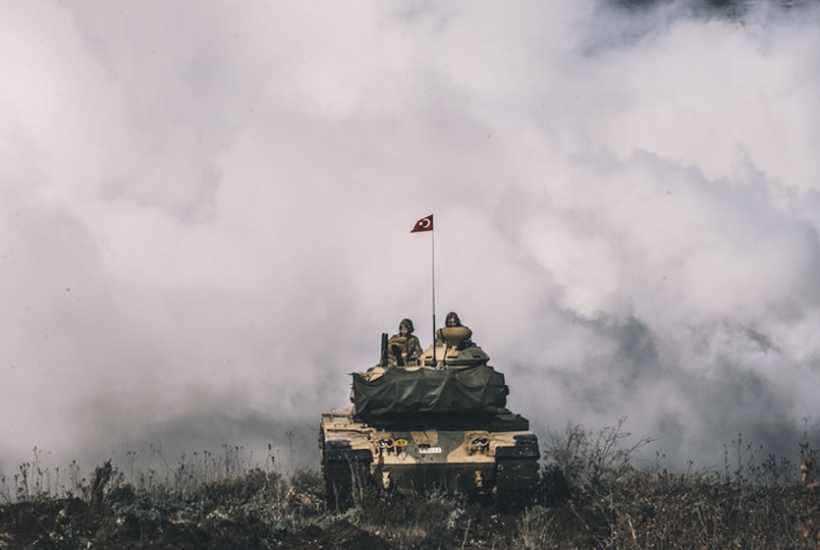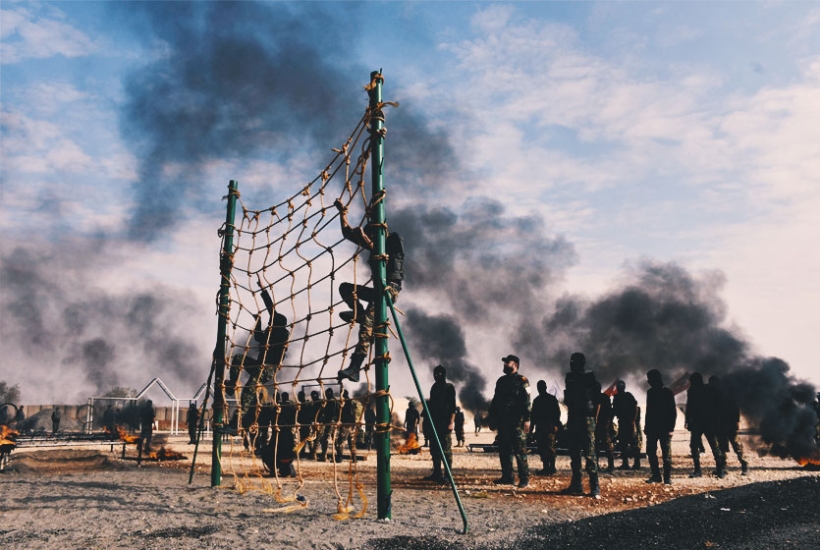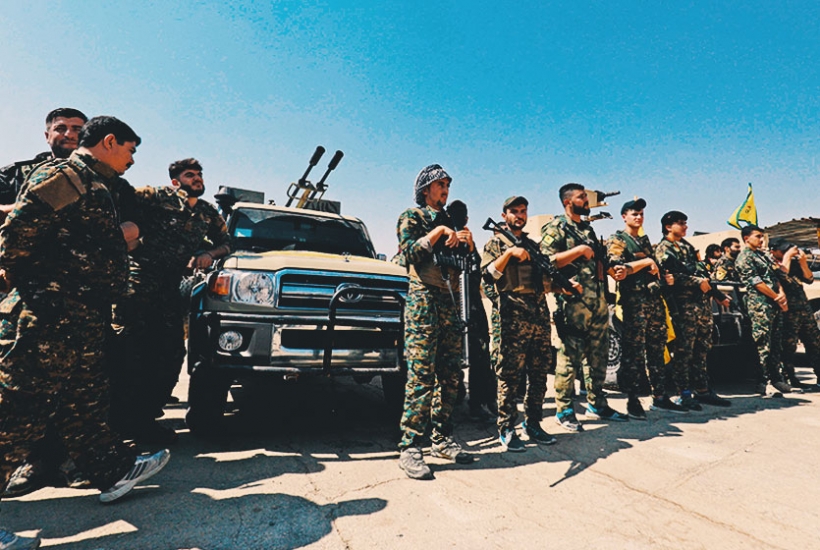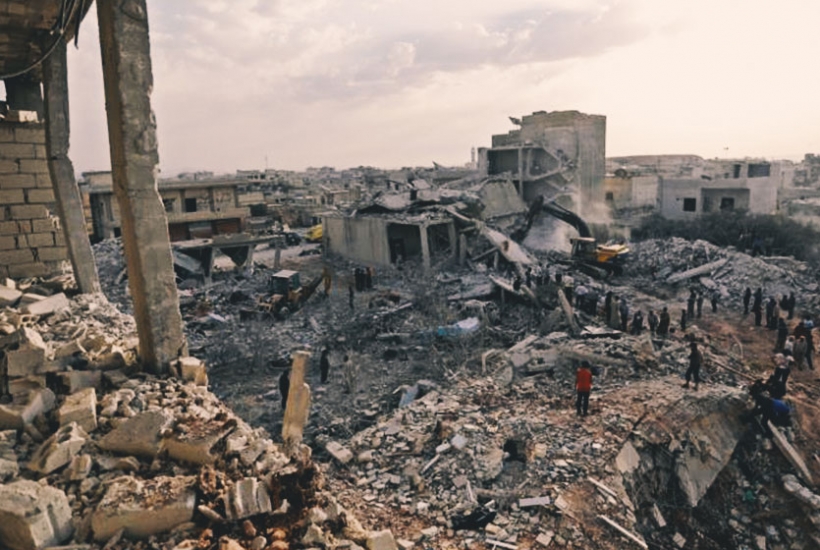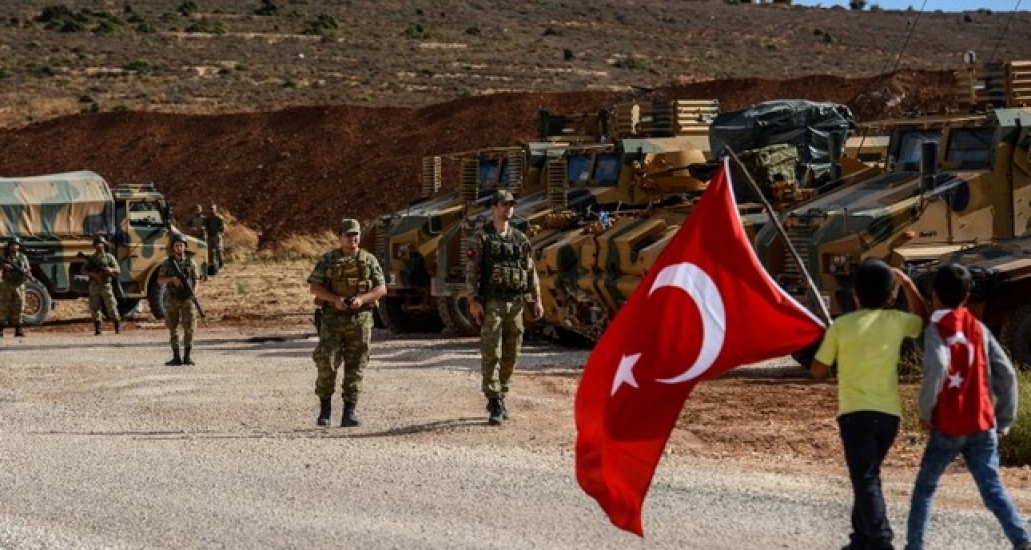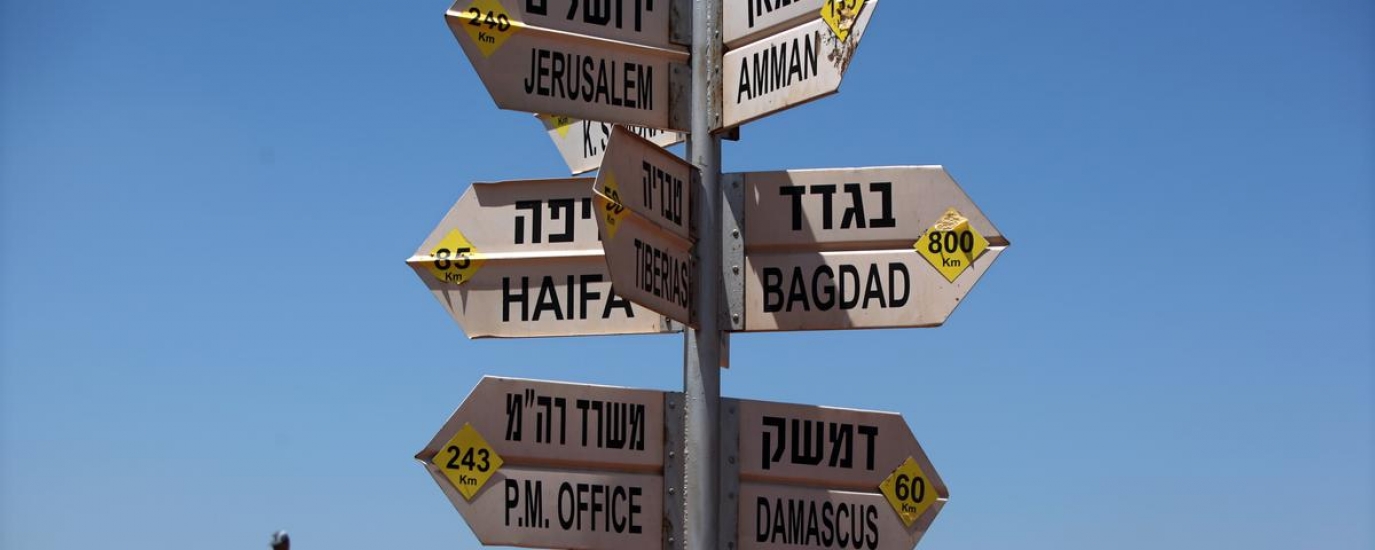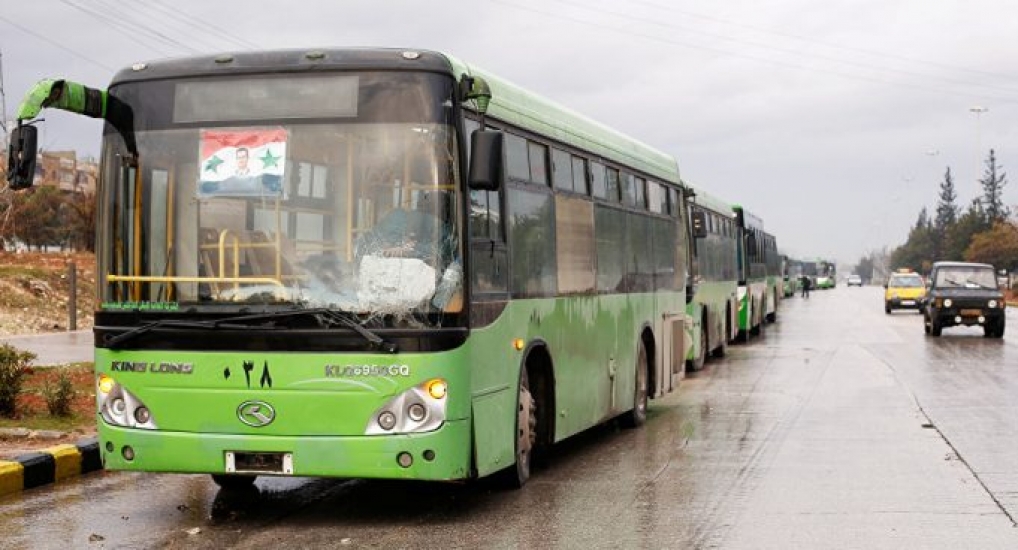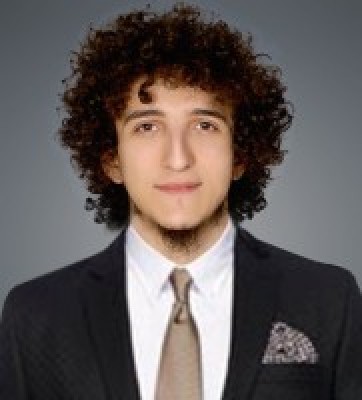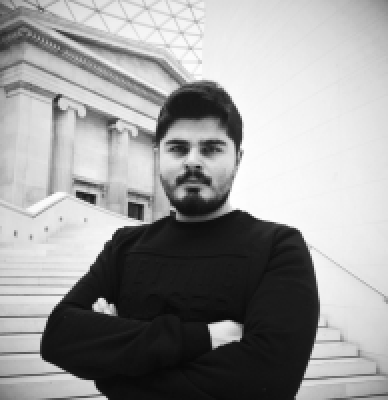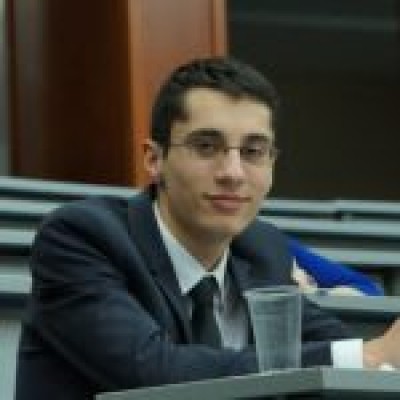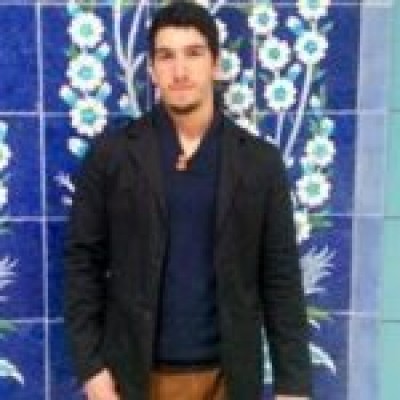Analysis
Occupy, Annihilate, and Rule: Russia Implements the Grozny Model in Idlib
The Grozny model is a tactic based on the sequence of occupy, annihilate, and rule. This model was adopted by the Russian Federation in the two wars it waged against Chechnya in North Caucasus in 1994 and 1999. It is originally inspired from the Nazi Germany’s Blitzkrieg method against the Soviet Union during World War II. The Grozny model relies on breaking the adversary’s line of defence with sudden and swift attacks, annihilating the targeted area, and forcing the opponent forces to surrender through blockade. This entered among the fighting tactics used by Russia especially against guerilla combat.
The 12-Year War
With the dissolution of the Soviet Union in 1991, its 15 constituent republics declared independence, which set an example for Chechnya. In 1994, Chechnya sought independence under the leadership of Dzhokhar Dudayev, but Moscow formed an opposition and supported them in military and political terms in order to hamper the independence movement, which fomented the Russian-Chechen conflict. The conflict between Moscow and Grozny lasted around 12 years, with the exception of a three-year ceasefire, and caused widespread devastation.
Firstly, during the First Chechen War that went on for two years, Russia under Boris Yeltsin’s rule did not yield tangible results although it had a major superiority over Dudayev’s Chechnya. In the clashes that took place around Chechnya’s capital Grozny, Russia suffered from its lack of experience in the face of the guerilla war and was caught off-guard by the abrupt attacks organized by its enemy. During the two-year period until the ceasefire of 1996, tens of thousands were killed, around 500,000 people were displaced, and many cities, particularly Grozny, suffered great damage.
The foundations of the Grozny model, which still in the present day is a preferred method, were laid in the First Chechen War. However, the first war where this tactic was fully applied and yielded tangible results was the Second Chechen War. The failure in the First Chechen War did not only pave the way for the second war, but also played a significant role in Vladimir Putin’s becoming the president of Russia. Having gained experience in the guerilla methods, this time, the Russian military almost destroyed Grozny, killed many critical names of the insurgency including Shamil Basayev, and forced the insurgents either to escape or surrender by besieging the region for a long time. Moscow finally appointed a pro-Moscow government head (Akhmad Kadyrov and his son Ramzan Kadyrov as his successor) who could keep the Muslim population under control and prevent other regions from following a similar path.
Inasmuch as the Grozny model is inspired from the Blitzkrieg tactic, these two models actually differ in terms of the time-result dimension. The Grozny model prioritizes obtaining long-term and permanent results in the regions it is applied, and if necessary, allows for the damage or the siege to be used as a trump card against the target country or region. Now, we observe that Russia is implementing the Grozny model in the Syrian war, especially in Idlib.
Same Tactic in Syria
There are multiple facts that demonstrate that the Russian military action in Syria carries marks of the Grozny experience. Two cases are particularly noteworthy, namely Aleppo and Idlib. In addition, the same model was also employed in Homs and Ghouta, but the cases of Aleppo and Idlib are more significant due to their overall importance, effects, and outcomes. The Assad regime and its allies couldn’t achieve any progress in the first four years of the war. As in the First Chechen War, the regular army could not overcome the guerilla tactics until Russia’s involvement in 2015.
With Russia’s involvement, the balances in the field started to change in favor of the Assad regime, and Aleppo ended up being under the regime’s control owing to Russia’s support. Russia applied the Grozny model in Aleppo. Firstly, Russia’s intense air attacks broke the blockades of the opposition forces, cut off the supply lines extending to Aleppo from the north and Azez, and ravaged a number of areas. Subsequently, the pincer movement gained momentum and the only land route leading up to the region was rendered unusable through heavy shelling. Lastly, the region, which was completely besieged and disconnected from all the supply lines, became an unlivable place as a consequence of increasing air bombardment and shelling. The opposition forces gradually receded after suffering heavy losses and the regime ultimately seized control. Looking at the record of this war that lasted over four years, we see that more than 23,000 civilians were killed, the region was completely ravaged, and its population was displaced. By applying the Grozny model in Aleppo, Russia got what it wanted once again through massive devastation.
The Idlib Case
Another location where Russia nowadays implements the Grozny model is Idlib. As in Grozny and Aleppo, Russia and the regime forces are gradually rendering the opposition forces ineffective and seizing control. Housing around 4 million people, Idlib is one of the most war-torn regions in Syria, and both receives and sends the highest number of immigrants in the country. Idlib’s position is rather different from Aleppo’s in terms of population density and the configuration of opposition forces in the region. In order to break the resistance of anti-regime forces across the country, Moscow attaches a particular importance to Idlib, a stronghold of the opposition forces.
The balance of power in Idlib started to change as it did in Aleppo in 2015 as Russia started heavy air bombardment and shelling. But despite this, the field dynamics and Turkey’s role as an active power in the region prevented the regime forces’ seizing full control of Idlib. Russia’s air attacks increased, in line with the first step of the Grozny model, causing the displacement of millions of locals. Meanwhile, on May 4, 2017, due to the growing conflicts, Turkey, Russia, and Iran signed a deal to create safe zones inside the Idlib province. This deal, however, did not stop Russia and the regime forces. Inhabited spaces including safe zones were ravaged and the civilian population had to flee.
The humanitarian crisis in Idlib became a key subject in the diplomatic relations between Turkey and Russia. As a result, the two countries agreed to create a demilitarized zone on September 17, 2018. But this agreement, too, did not prevent Russia’s air attacks, and the devastation continued. In addition, Russia and the regime forces continued their military advance through the blockading of land. Murak and Suman are two examples, along with similar military advances from Karati and Katrah to Carcanaz. Furthermore, advances and retreats from Katrah, Barnan, and Istabalat towards the west and north were experienced and severe clashes took place. Eventually, the number of displaced people reached around 1.6 million. As of November 2019, 310 civilians have been killed whereas the material damage in Idlib has exceeded $320 million. The infrastructure and superstructure of the region have become unusable and life has come to a halt.
Deliberately causing severe damage in Idlib has other purposes as well. Especially recently, Russia has been planning to trigger massive flows of refugees which it aims to use as a card against the neighboring countries. Millions of displaced people eventually threaten the internal stability of host countries and pose a security threat. Russia wants to use this card at the negotiation table.
The Grozny model is an occupy, annihilate, and rule tactic. Russia formerly applied this in Chechnya, and now it plans to control Syrian dissidents by employing this model. Russia implements the same model to entire Syria in order to protect Assad and to eliminate threats that might undermine Russia’s political and commercial interests in the region in the long run. But the outcome of the model is the same everywhere: hundreds of thousands of displaced civilians, tens of thousands of casualties, and a whole slew of destroyed cities. Despite being disgraceful in humanitarian terms, Moscow’s Grozny model continues to create advantages for Russia and its allies, and stands out as an instrument in realizing Russia’s long-term goals.
https://thenewturkey.org/occupy-annihilate-and-rule-russia-implements-the-grozny-model-in-idlib
Syrians In Turkey and The Whole Picture
Syrians In Turkey and The Whole Picture
Perhaps one of the most dangerous mistake, both at the political or socio-economic, is the failure to see the full picture and getting stuck at the current moment, without realizing the picture’s backgrounds and consequences. As such, people are unable to realize the roots of the Syrian people’s revolution and its causes; how others attached to a particular moment; insist on the interpretation of the present and the past through this moment. We can also talk about the failure of some to realize the roots and backgrounds of terrorism in Syria and beyond. Not to mention their inability to monitor the role of the parties that sponsored and enlarged the terrorism in our land.
Reading the change in the world over the past years through a similar perspective reveals how the events have been affected which end up with absolute devastation. At this point, I, Head of the National Coalition for the Syrian Revolution and Opposition Forces, think that it is more important to remember the role played by the international community and how it always failed to deal with the situation from the very beginning. This deficit of solid, firm and solution-oriented international efforts is what allowed the regime to continue its crimes against humanity which ended up with mass displacement and successive waves of refugees. These refugees found themselves in several regions including Europe. After their arrival in the European countries, the far-right in those countries started to exploit this situation and the mood of the continent was started to affect relatedly. The attitude put forward by the far right is an unprecedented one and the impact of this on the vote to Brexit ought not to be overlooked.
This approach can further help us while dealing with the reality of Syrian refugees in Turkey. In this way, we will not dwell on past events. On the other hand, we will be able to look outside the box and analyze closely at the scene and details of the origins of the problem. By doing so, it becomes possible to foresee the possibilities for prospects and to build a vision through which we change the reality and the future.
Data based on facts and figures presented by the research report issued by the Euro-Mediterranean Forum of Economic Institutes of Science “FEMISE” published recently under the title of “long-term effects of Syrian refugees on the Turkish economy” help to shed light on the side of this approach.
Historic Brotherhood
At the outset of the analysis, a quick return to the past is a must. Starting from the long historical relationship that linked the people of the region over a thousand years ago, turning back to times when the Syrian soldiers fought along with their Turkish brothers’ shoulder to shoulder in Canakkale Battle one hundred years ago, the current brotherhood between them seems not so surprising. That brotherhood brought out several parties and entities which had been engaged in deciphering this relationship. They were and still are trying to disrupt every way possible to transform the region into a group of scattered helpless islands.
If we go back just a few decades, we will find a huge rupture between Syria and Turkey, as if there was a vast ocean separating both countries. Nevertheless, the developments successively beginning of 2003 and then especially after 2011, revealed to all that all of these efforts and plans have failed as the peoples of the region know themselves and their history.
Syrians in The Turkish Economy Since 2011
Based on the report issued under the auspices of the European Union, it would be better to note the impact of 3.6 million Syrian refugees on the Turkish economy as they will lead to a doubling of Turkey’s GDP at a rate of 4%. Furthermore, Syrians invest in Turkey reveals a strong ability to organize and manage projects.
While some people just consider the temporary negative effects, the report puts forward that the contribution made by the Syrian labor force in terms of reducing the cost of production has a stimulative impact on the economy. Confirming what was predicted that the production capacity of the Syrians in the establishment of projects is more significant than of their consumption on the Turkish economy. We are confident that the implementation of further measures to support the Syrians and their chances of organizing work will certainly increase their support for the economic growth of Turkey.
Other reports indicated that the Syrians have established more than 10 thousand companies in various sectors since 2011, and it is similar in the various countries that have received the Syrians such as Germany or the other neighboring states. They quickly realized that the Syrian refugees represent a powerful ability and capability that could help them to cope with economic problems, to work and to create despite the cultural barriers.
As specialists in this issue know very well that the cross-cultural interactions are among the most important emitters of creativity and innovation. Such as Steve Jobs, founder of Apple, is the son of Syrian refugees, as well as Sergey Brin, a founding partner at Google, is the son of a Russian refugee. There are many other examples of those people who did tremendous work had a cultural interaction in their background.
Such creators are everywhere and all they need is a safe environment that preserves their rights, afterward, innovation becomes a matter of time, especially for the Syrian people since they are very hard-working people.
Procedures in Need of For Syrian Refugees and Joint Syrian-Turkish Committee
Syrian refugees’ contributions to the economy have already emerged even though a large proportion of them are still unemployed. Today in Turkey, more than two million Syrians are at working age (men and women) and only half of them are employed. Numbers are inaccurate, but there is a need to fix this situation and to address the problem of the Syrians working outside the framework of law with low wages far below the minimum wage and sometimes under harsh circumstances.
Job creation, support, training, and recognition of previous education certificates in addition to providing opportunities for follow-up education are crucial for the integration process of Syrians. Not only on the economy but the cultural, social and political levels as well, investment is the best way to deal with the abilities of the Syrians rather than wasting or restricting them.
Given all these facts, it seems the presence of Syrian refugees in Turkey, is an exceptional opportunity to put the history back on track. It would be very imperative to promote coexistence and cooperation in a way where everyone wins.
We have made huge efforts over the past months under the framework of the “Joint Committee” between the Syrian Coalition and the Interior Ministry of Turkey, to discuss and resolve the problems being faced by Syrian refugees e.g. problems related to their residence.
No doubt learning the language and obtaining respect for the customs and traditions of the locals are of utmost importance, and we have to emphasize this aspect in conjunction with the preservation of our language and traditions. Syrians do not want a substitute homeland, and they did not start their revolution in search for immigration and asylum, but to build a nation that protects their rights and allows them to perform their duties in the development and reconstruction.
Spring Peace Operation and The Safe Home for Refugees
Today, Syrians who have the possibility of returning to their home in secured areas began to return voluntarily. Most of them prefer to work for the reconstruction that has become possible through the Turkish operation of Euphrates Shield, Olive Branch, and Spring Peace.
Syrian Interim Government began to form local councils in both Tal Abyad and Ras al-Ein to be able to provide services to citizens. It assumed the duty of ensuring refugees’ safe return. In addition to that, it started to formulate police forces and to deploy them into the region to maintain security.
The return of Syrian refugees to their homeland must be achieved properly under the context of a political solution towards their aspirations that also preserves their rights. This framework should consider the current circumstances and create accordingly. It can be utilized as an opportunity to achieve economic and social integration during the post-solution stage and can be seen as an inception for stable bilateral relations.
Conclusion and Recommendations
What we are working on and care about what we are seeking to cooperate with the Turkish government is to continue to hold seminars, conferences and specialized studies focusing on the issue of asylum and mechanisms to deal with it. We aim to benefit from the experiences of other countries and to get recommendations. Hence, we take the economic and administrative decisions to contribute to easing the regulatory burden on the displaced Syrians in Turkey. In addition to improving the business climate for small and medium enterprises, we promote for better export sector and integration process with the Turkish economy. Successful projects, as well as training plans for entrepreneurs, help them to create solid and beneficial projects.
We are doing everything within our means to support the education sector. We cooperate with the Turkish government for the integration of Syrian students in schools. We try to overcome and prevent any kind of problem in schools beforehand such as school dropouts.
This issue does not only have human, moral or religious dimensions, on the other side, but there are also political, social and economic benefits that can be in favor of everyone. However, this case ought to be dealt with an open mind based historical relationship retained by the memory of people. This means, there are very significant opportunities for today to take advantage of and to strengthen our ties to rebuild Arab-Turkish relations on solid foundations. The best investment is to invest in human beings. It represents a tremendous success that brings a huge impact on the conscience of the people. Let us remember together that the memory of the people is difficult to be forgotten.
Interfactional Dynamics And The Future Of Idlib Ömer Özkizilcik
Interfactional Dynamics And The Future Of Idlib
Interfactional Dynamics And The Future Of Idlib
Since the planned wide-scale military operation by the Assad regime in July 2018 against the different military factions, Idlib has been the center of the Syrian conflict. On January 1, 2019, renewed clashes between Hayat Tahrir al-Sham (HTS), the former Al-Nusra Front, and the Nureddin Zengi Movement brought Idlib again at the epicenter of the Syrian conflict. Now, HTS has become a dominant power in the region in terms of controlling territory, and has become capable of transforming Idlib. This paper aims to give a brief overview of the recent battle and the dynamics inside Idlib which led to the fighting between the Nureddin Zengi Movement and HTS. Furthermore, the dynamics which enabled HTS to win the battle will be analyzed. Based on the implications for the interfactional dynamics in Idlib, the Sochi agreement between Turkey and Russia has to be adjusted given that certain of its terms couldn’t be implemented on the ground. The paper also offers an array of possible scenarios of how Turkey and Russia might adjust the Sochi agreement in order to counter the violent extremist group in Idlib and prevent a humanitarian crisis.
Source: https://www.setav.org/en/analysis-interfactional-dynamics-and-the-future-of-idlib/
Four Scenarios for Idlib and the Future of Hayat Tahrir al-Sham
Four Scenarios for Idlib and the Future of Hayat Tahrir al-Sham
On January 1, 2019, renewed clashes occurred between the former Al-Nusra Front Hayat Tahrir al-Sham and the Nureddin Zengi Movement which is part of the Turkey-backed National Front for Liberation. As a result of these clashes in western Aleppo, Hayat Tahrir al-Sham (HTS) managed to expel Nureddin Zengi and crushed Ahrar al-Sham and Suqour al-Sham who joined the battle to help Nureddin Zengi against HTS. As HTS came out as the winner of the battle, militants managed to get control over strategic areas in Idlib and to force the administrative handover of almost all areas inside Idlib to the HTS-backed ‘civil government,’ called the Salvation Government. The military operation by HTS could be divided in two steps and it will have serious implications for the Sochi deal.
The First Phase: Eliminating Nureddin Zengi
Hayat Tahrir al-Sham started a wide-scaled military operation against the Nureddin Zengi Movement in western Aleppo to disband the later. In excuse for its attitude, HTS argued with the killing of 5 of its fighters by alleged Nureddin Zengi members and the alleged refusal of Nureddin Zengi to implement the reached deal to handover the suspects to a court. While Nureddin Zengi sources and the leader of Ahrar al Sham refused the claims of HTS that Nureddin Zengi haven’t handed over the suspects, HTS already started its military operation, sparking allegations the group was misusing this incident to gain control over strategic areas.
After HTS started its assault on areas held by Nureddin Zengi, primarily the strategic Darat Izzah which links western Aleppo to Afrin, the later put up a strong resistance. However, as Nureddin Zengi lost the strategic hill at Sheikh Barakah, the town of Darat Izzah was captured by HTS on January 2. After the loss of the strategic town, the General Command of the Turkish-backed National Front for Liberation declared a general mobilization against HTS and called upon all elements of the umbrella to put up a fight against HTS. However, the call by the General Command of the National Front for Liberation wasn’t answered by factions of the umbrella except Ahrar al-Sham and Suqour al-Sham.
On January 4, HTS succeeded in capturing all areas held by Nureddin Zengi in western Aleppo and remnants of the later fled to the Afrin region leaving tanks and other heavy weapons behind. During the fighting between HTS and Nureddin Zengi, some sporadic clashes erupted between HTS and the Turkish-trained National Army. That night, the Russian air force bombarded areas captured by HTS in western Aleppo.
On January 5, HTS put pressure on the independent town of Atarib which was known for its fierce resistance against HTS and former Al-Nusra Front. As Nureddin Zengi was defeated, Atarib got surrounded by HTS and representatives of the town made a deal with HTS to handover the city to the extremists. According to the agreement, people who were wanted by HTS were allowed to leave the area towards Afrin. The loss of Atarib is important as the city was a role-model of non-violent resistance against HTS.
Second Phase: Crushing Ahrar al-Sham
On 6 Junuary, HTS started the second phase of its operations to crush Ahrar al-Sham in the Ghab Plains. The day after, HTS managed to get control over Al Abideen, Suth Al Deir, Araniba, Al Naqeer and Termala and pushed into the Ghab Plains. After several advances in the northern part of the Ghab Plains and in Jabal Shasho, HTS and the local Ahrar al-Sham units signed an agreement under which all Ahrar al-Sham units in the region handover the region and their heavy weapons to HTS and were allowed to flee to Afrin in return. With this gain, HTS managed to isolate the presence of Ahrar al-Sham in Ariha and Marat al Nouman.
On 10 January, HTS and Ahrar al-Sham together with Suqour al-Sham signed a ceasefire agreement. The deal provides for an immediate cessation of hostilities, an exchange of detainees, the lifting of all checkpoints inside the region, and its unification under the authority of the Salvation Government meaning that administrative duties will be under the control of the HTS-backed ‘civil government’.
Implications for the Sochi Agreement
Developments on the ground in Idlib and a bigger HTS presence will have serious implications for the international context and the signed Sochi agreement between Turkey and Russia. After Turkey’s decisiveness to prevent a new humanitarian disaster in Idlib, and diplomatic pressure from western countries on Russia, Russia and Turkey signed the Sochi agreement. According to the agreement, a demilitarized zone should have been established along the front lines of Idlib. This demilitarized zone had to be cleared of radical elements such as Hayat Tahrir al-Sham and heavy weapons of the Syrian opposition factions. As a second step, the strategic M4 and M5 highways which link Latakia and Damascus with Aleppo should have been opened to free trade, but with the newest HTS campaign against the Syrian opposition, four different scenarios of the fate of Idlib may occur:
Starting a Turkish military operation into Idlib to clear the area from HTS
Approving a Russian-led military operation by the Assad regime while establishing a humanitarian safe-zone along the Turkish-Syrian border
Rebranding HTS into an acceptable structure
Freezing the dispute over Idlib and gaining time
The first scenario seems to be the most unlikely among the listed. Turkey’s priority in its fight against terrorist organizations in Syria is the PKK/YPG. Also with the US withdrawal declaration, Turkey’s focus is on east of the Euphrates and Manbij. Additionally, Turkey’s military has to focus on the Aegean, the Black and the Mediterranean Sea while fighting terrorists inside Turkey and preparing a major operation into Syria’s northeast. Therefore, Turkey’s military will most likely not want to get involved into another major fight in Idlib.
The second scenario to approve a Russian-led military operation towards Idlib is a worst-case scenario for Turkey. A hugely feared humanitarian disaster will happen, and Turkey would see millions of refugees at its border trying to enter inside Turkey. As Turkey already hosts over 4 million refugees, this scenario would have a catastrophic outcome for Turkey. The burden of this scenario might be eased with a humanitarian safe zone along the Turkish border, but this wouldn’t be effective enough. Also the costs for Russia in such an operation would be very high which will be a topic Russia will think twice of.
As a theoretical third scenario, Turkey could try to change HTS internally into an acceptable structure to ease Russian pressure and to take Idlib into the transition process. Turkey already worked in separating the dogmatic wing of HTS and the pragmatic wing, strengthening the later. After the former Al-Nusra Front cut its ties to Al-Qaeda it rebranded itself as Jabhat Fath Sham and later formed HTS together with other factions in Idlib. After the formation of HTS, former Nusra sub factions who rejected cutting ties with Al-Qaeda defected and formed Hurras Eddeen. However, this scenario seems not to be a realistic perspective. Neither is HTS willing to change, nor is the international community ready to accept a rebranded HTS.
Postponing the time in which a solution for Idlib has to be found and implemented may help Turkey find a new window to act as a fourth scenario. For example, if the situation in the east of the Euphrates and Manbij becomes clear and the dust settles down, the Turkey-backed Syrian opposition might return back to Idlib. Also for the Russian side, a military operation in Idlib would be very costly and expensive. The Russians would need the active support of Iran-backed Shia militias to advance on the ground in the highly fortified region of Idlib. Russia is also aware that such an operation would take several months at least, and it would have to deal with HTS guerrilla warfare in captured areas. All in all, to freeze the situation in Idlib might be an option for Turkey and Russia, but a safe haven for Al-Qaeda affiliated radicals has to be prevented. Therefore, Turkey and Russia could agree on extended intelligence sharing to contain this threat. Also, the US might join hands with Russia and Turkey in these efforts.
Source: https://thenewturkey.org/four-scenarios-for-idlib-and-the-future-of-hayat-tahrir-al-sham
Combatting Criminal Gangs in Northern Syria Ömer Özkizilcik
Combatting Criminal Gangs in Northern Syria
After Turkey and the allied Syrian opposition factions launched Operation Euphrates Shield and Operation Olive Branch, both areas in northern Aleppo and Afrin were cleaned from Daesh and YPG militants. After the success of these military operations, the Syrian opposition and Turkey invested in reconstructing, re-organizing, and re-building these liberated areas. However, the war-torn region faced a new security challenge, especially after the massive arrival of new internally displaced peoples (IDPs) from Ghouta, Homs, Hama, Derra, DeirEzzor, Raqqa, and Manbij. While Daesh and YPG cells have tried to sabotage the new administration of the Syrian opposition with terror attacks, other criminal gangs took advantage of the situation.
Although Turkey invested a lot to help the Free Syrian Police and the National Army recruit and train, criminal gangs exploited the weak security situation to harm the local population. Only after both Turkish-trained structures reached a certain level, on 19 November, the National Army and the Free Syrian Police started a wide-scale operation targeting those criminal gangs with the support of Turkey. The entire operation also gives a hint about the future security problems awaiting in Syria.
Catching the big fish first
The security operation by the National Army and the Free Syrian police successfully disbanded the Shuhada al Sharqiyyah faction after a day-long fight. Shuhada al Sharqiyyah is a DeirEzzor originated faction that had to flee from its hometown towards northwest Syria due to the Daesh threat. After the liberation of Al-Bab from Daesh, Shuhada al Sharqiyyah broke the ceasefire with regime forces at Tadef and tried to escalate the situation. After this incident, Ahrar al Sharqiyyah, which is a component of the National Army, cut its ties with Shuhada al Sharqiyyah, and the faction was disbanded.
Over time, Shuhada al Sharqiyyah reorganized itself under the leadership of Abdurrahman el Huseyn, who is also known as Abu Hawl. While some claims suggest the faction to have up to 400 fighters, figures near 100-150 seem more realistic. After the faction reorganized itself in Afrin, it started to commit several crimes against the local population, including robbery, extortion, and other criminal activities.
On the evening of 18 November, a curfew was declared over Afrin, and the day after, the National Army and the Free Syrian Police started a joint operation with the support of the Turkish Armed Forces in order to disband the faction, to arrest its members, and to hand them to the criminal court. With the start of the operation, the Shuhada al Sharqiyyah faction showed fierce armed resistance using heavy weapons. This resistance led to clashes between both sides, which continued over midnight. Nevertheless, the National Army and the Free Syrian Police succeeded and arrested the faction members. During the clashes, several members of Shuhada al Sharqiyyah were killed and injured.
With these clashes ending in a determinate result of disbanding Shuhada al Sharqiyyah, the National Army, the Free Syrian Police and Turkish authorities displayed their decisiveness to combat criminal gangs in northern Aleppo and Afrin. With the end of these clashes, the leadership of the National Army published a new statement, saying: “Our Security Operation Will Continue!”
The second phase
On 20 November, the National Army leadership published a statement saying that they will continue with their security operation. The operation continued in Al-Bab in which several criminals were arrested and handed over to the Military Police of the Free Syrian Police. In contrast to the first day of the operation, criminal gangs have not attempted to resist against the National Army or the Free Syrian Police, as the decisiveness of the operation had become crystal clear.
Also, in contrast to the first day, the Military Police played a bigger role in arresting several in Al-Bab. However, a commander in the Northern Brigade, which is a component of the National Army told the author that all operations were spearheaded by the National Army. As seen on several images, the operation was conducted with heavy weapons in case of resistance from armed criminal gangs. Among the arrested in Al-Bab were Mohammed Abdulkarim Jard, Abdurrazzaq Waki and some remnants of Shuhada al Sharqiyyah in the village of Tal Aisha, north of Al-Bab.
During the same day, the Free Syrian Police captured a bomb loaded vehicle inside Azaz, which may be another sabotage and terrorism attempt by either YPG or Daesh militants. Due to the geographical situation of Azaz, which is close to YPG-held Tal Rifaat, YPG militants are the most likely suspects. Also, on the same day, Firka Hamza, which is a component of the National Army, handed over its checkpoints in Basuta in the Afrin region to the Free Syrian Police. At the end of the day, the Chief of Staff of the National Army published a statement, which imposed a curfew over Jarabulus for 21 November.
On 21 November, the security operation continued in Jarabulus, and a curfew was imposed on the city. Several criminals were arrested by the National Army and the Military Police of the Free Syrian Police and with the withdrawal of the National Army, the city control was fully handed over to the Free Syrian Police again. Within the third day of the operation, the Jarabulus court published a statement calling for people to file criminal complaints. At the end of the day, the leadership of the National Army published a new statement imposing a curfew over Al-Rai.
With the start of the operation on 22 November in Al-Rai, a criminal subgroup of the Jaysh al Sharqiyyah faction, which is a component of the National Army, surrendered themselves to the National Army and the Military Police. Together with other criminals in Al-Rai, the Military Police arrested 17 people. At the end of the day, the locations of Azaz and Akhtarin were declared as the next target of the operations. On 23 November, the Military Police arrested 3 different criminal gangs and 3 individuals in Azaz and Akhtarin. The Marea and Tel Rifaat Military Councils declared that they will also arrest criminals in Marea and hand them over to the Military Police.
The last operation was conducted on 24 November in Jinderes which is located in the Afrin region. The National Army and the Military Police arrested around 50 criminals and 8 criminals surrendered themselves to the authorities. At the end of the day, the National Army leadership published a statement declaring the end of the operation while pointing out that efforts against criminal gangs will continue.
After the security operation
While the entire operation began with a huge challenge, and all operations following were reported by several media outlets as “internal fighting among Turkey-backed groups,” in reality, it was a “clean up” operation, with the backing of Turkish Armed Forces. An important period of training, organization, supply and supervision by Turkey, the National Army, and the Military Police of the Free Syrian Police, succeeded to disband a strong faction, which proved the effectiveness of Turkish efforts inside Syria.
Source: https://thenewturkey.org/opinion/combatting-criminal-gangs-in-northern-syria?fbclid=IwAR1OJJFYRmu4jy0BNmU_CriWBRmCWJvRSd8gxza8XewmxggHZ3wquasGOGU
Making Sense of YPG’s Strategic Threat Posed Against Turkey Furkan Halit Yolcu
Making Sense of YPG’s Strategic Threat Posed Against Turkey
There are certain methods to analyze the threat posed to states by insurgent and terrorist organizations. One may work for the best of this paper is the method that categorizes the ideological strings, capacity and the logistics of the terrorist and insurgent groups to see the rationale behind their threat posed against the states. Modern states base their survival on two instinctual defense mechanisms, namely territorial integrity and sovereignty. This paper is going to reveal how and why YPG/PKK terrorist organization is an active menace for the Turkish territorial integrity and sovereignty.
The “Great Design” of YPG/PKK
As mentioned in Ocalan’s book of “Road to Kurdish Revolution- A Manifesto” which he established PKK’s ideology, there is a certain bargain that the terror organization wants to strike. The way to obtain this bargain is certainly an organized method of utilizing coercion towards the Kurdish people to organize and force them against the states, which are antagonized. The states antagonized in Ocalan’s ideology are Turkey, Iran, Iraq and Syria, which uphold the “Kurdish Heritage” according to him and other PKK ideologists. Every ideology as in the case for PKK also, requires a utopia or a “great design” where the bargains and ends are achieved through the methods suggested by the leaders of the movement. In Ocalan and YPG/PKK’s case, this is the case of a “National Democratic Kurdish State” which will base its institutionalization on socialist and Marxist values. In addition, every great design requires a territorial “design” (imagination) and in Ocalan and PKK’s ideology it is the great Kurdish territory, which categorically includes lands from, the four countries mentioned above. The practical design of this ideological program is to establish a “Democratic Confederation” which will include one confederation from each country. This is one of the most important reasons behind the threat perceived by the Turkish state from YPG/PKK in Syria and Iraq. Although there are political boundaries, each of these four states grasp the idea behind the YPG/PKK and the other branches’ moves towards the “great design” which means the loss of territorial integrity for these nation-states. It is quite obvious that nation-states are designed to protect their borders no matter what the cost is in the long term.
This makes it very feasible to understand why Turkey feels threatened by the mere existence of YPG/ PKK in both Syria and Iraq. The mere ideology itself is a threat to Turkey’s territorial integrity thus even YPG/PKK demilitarize themselves it would be rational for Turkey to absorb and insulate the ideology as much as possible.
The Capacity-Threat Correlation
States do not perceive threat per se without any actual organization that holds a certain amount of capacity to use force. The number of militants in the PKK terrorist organization is asserted to be more than 6000. The one third of this population is believed to be in the Turkish soil preparing and managing the attacks and logistical matters. When it comes to YPG the numbers are much higher. It has been asserted many times that YPG has more than 30.000 militants across the Syrian border. The total number of manpower in the hands of YPG/PKK should be more than 50.000 when the YPG/PKK activities in Deir ez-Zor and the other east southern parts are taken into consideration, as well.
Additionally, there has been many incidents where the weapon systems such anti-tank, man portable systems and explosive substances that are given to YPG/PKK and then transferred to Turkey through tunnels built mostly in Mardin and Diyarbakır provinces. Strong evidence towards this phenomenon was discovered during the clashes between Turkish Armed Forces and PKK militants in Nusaybin/Mardin. In this border district it was revealed that PKK had been transmitting goods and military equipment through tunnels that opens to Syria. This development transformed into a rationale for TAF to determine the annihilation of YPG/PKK militants in a holistic sense.
It is not only the militants that doubts the states when it comes to popular movements but its the people who support these fight conducted by the guerillas. The number of Kurdish-origin citizens in the demographic mosaic in Turkey is believed to be around 13 million. This causes an assertive reaction from the Turkish state against any movement that has the mobilization of Kurdish people as a mean to reach a higher goal. So the Kurdish-origin citizens of Turkey become an integral part of this equation. The ideology promoted by the leaders of the organization usually tries to mobilize the people in terms of creating a more massive movement. As Ocalan designates the reformists, as “recreant” Kurds who betray the Kurdish cause and choose to stay within the incumbent state’s boundaries. As for all ideologies that oppose a given status-quo YPG/PKK’s ideology also endavours a great change in the circumstances which constrain the Kurdish folk into a dichotomy. According to PKK’s ideology Kurds all around the world and especially the people in those four states are bound to choose between supporting “the cause” and betraying the cause. This is of course a technique widely used in propaganda making which is called framing. Therefore both in the manpower and the influential manners YPG/PKK has a potential that turns them into de facto strategic threats.
The Principle of Proximity in Security
The designation of a threat as “strategic” requires a certain type of circumstances and some type of reasoning. Let us assume there are 5000 YPG/PKK militants in the border areas of Iraq and Syria and 50000 YPG/PKK militants in New Zealand. The rational state behaviour would dictate that the most imminent threats should be taken into consideration more than the other ones even though those bear a higher potential. This is called the principle of proximity in state security and it has a certain type of rational thinking that is accurate usually.
Since the YPG/PKK militant clusters are usually near the Turkish-Syrian border the threat posed YPG/PKK is perceived as a more strategic threat than the other threats such as economic breakdown, the Syrian crisis as a whole etc. There has been rumours that YPG/PKK was prepared to invade Turkish territory in the exact night that the failed coup d’état attempt took place in 15th July. Even the rumour itself proves that in the minds of the Turkish decision-makers YPG/PKK poses a constant threat for the territorial integrity of the Turkish state. It is quite rational for Turkish decision-makers to perceive YPG as a strategic threat per se and with each canton established the threat becomes more imminent. This was the basic rationalé behind the Olive Branch Operation as Turkey successfully impeded the plans to construct a border cluster of YPG/PKK militants which would pose a liquid threat that would use its potential in a matter of moments in case of any kind of turmoil in the country.
All being said, Turkey’s rationale behind the threat perceived by YPG/PKK is based on realistic assumptions in both the theoretical and practical sense. Since the ideology of YPG/PKK has a “great design” that insults the integrity of Turkish territory. Secondly, the organizational structure of it holds a potential to damage the state in an array of ways with the manpower they have and the popular support behind them. In the last phase, these two organizations pose a threat to the states they designate as “colonizers” since they are either in those states’ territory or next to their border. As any antagonistic organization with an ideology that targets means of one state’s possession, physical potential to damage or take away what is currently being controlled by the state and that is proximate, YPG/PKK have always been and will always be a strategic threat as long as they exist.
Sharing the costs of rebuilding Syria Ömer Özkizilcik
Sharing the costs of rebuilding Syria
In seven years of war, nearly half a million people have lost their lives due to killing by bombardment, torture or chemical weapons.
More than 6.1 million people have been displaced within Syria and another 5.6 million have fled the country as refugees.
The UN’s Economic and Social Commission for Western Asia estimated the costs of Syria’s reconstruction at $388 billion. As neither the Assad regime, nor its backers Russia and Iran, have the needed resources – and China’s support won’t be enough, the reconstruction of Syria should be divided into areas of responsibility between Turkey, the United States and the regime axis.
By doing so, Syrians may find a path to recovery in their country.
The destruction of Syria become exorbitant due to the tactics of the Assad regime – especially the scorched earth strategy used by the Damascus (and its backers Russia and Iran), leading to the destruction of entire cities.
In order to force Syrian rebels and civilians under siege to surrender or accept an evacuation deal, the regime explicitly targeted infrastructure. The bombing of hospitals, markets, administrative buildings, universities and schools by the regime and Russian air forces made living in those areas impossible, and forced the armed opposition to surrender.
Except in the case of Raqqa, the most significant destruction has been caused by the regime and its backers.
Areas of responsibility
In order to manage the reconstruction of Syria, conflict parties could agree to divide Syria’s reconstruction into areas of responsibility. This would enable parties to invest more efficiently, and it would also help Syrians – as rebuilding nations may compete to make each area of responsibility more liveable for civilians.
Even if the historical comparison lacks from many aspects, the case of Germany and its destruction after the Second World War may be an inspiration for Syria. Germany after the war was divided into four areas of responsibility, but has become the most successful united European nation. To divide Syria’s reconstruction into areas of responsibility would limit the costs for each party and would accelerate many funds into the rebuilding.
While US, European, Gulf and Turkish authorities may refuse to invest in Syria – fearing the empowerment of the Assad regime, a division of Syria’s reconstruction in areas of responsibility would enable parties to rebuild Syria with limited political obstructions. Turkey may be able to accelerate EU and Qatari funds into its areas and the US may be able to accelerate Saudi, Emirati and European funds into Syria’s reconstruction.
Trump’s current blockade on investments in Syria may end, but even if not, the next US administration would most likely follow another agenda.
The planned summit in Istanbul between Russia, Turkey, Germany and France will have huge importance in starting to find politically acceptable solutions for the reconstruction of Syria. Besides this summit, bilateral and multilateral meetings are ongoing. Even if international powers have not yet agreed upon a division of areas of responsibility to rebuild Syria, developments on the ground are following this path.
If the de-facto divisions on the ground evolve into an international agreement for reconstruction, all efforts may become more concentrated and effective.
Regime axis
Under today’s circumstances, states have already started to rebuild parts of Syria or at least started to plan it. Iran, Russia, Lebanon and China have started working in reconstructing territories under the control of the Assad regime.
Of these, China may become the most important for the rebuilding of Syria, as neither Russia nor Iran has the financial power to invest to the same degree. China sees Syria as a strategic link on its new Silk Road and has already agreed to fund $2 billion of rebuilding. Additionally, Beijing has announced a further $23 billion in loans and aid for the Arab region, including Syria.
More than 30 Chinese companies, including infrastructure construction giants China Energy Engineering Corporation and China Construction Fifth Engineering Division have visited the country.
Russia, meanwhile, acknowledges its inability to finance the reconstruction of Syria and sent a proposal to Washington requesting US assistance. Russia brought Syria’s reconstruction to the UN Security Council and tried to pressure the EU to pay for the rebuilding. Iran is also aware of its inability to rebuild Syria.
Both nations who supported the regime with military power, and who bear responsibility for the destruction of Syria, lack the resources to reconstruct Syria. Both nations remain under international sanctions.
Interestingly, tiny Lebanon is hoping for huge gains from the reconstruction of Syria. Lebanon expects to become an important actor in the rebuilding as it enjoys a lucrative geographical location between Syria and the Mediterranean Sea. Therefore, Lebanon can expect industrial transit to boom and plans to develop its port capability.
Turkish zone of responsibility
Turkey has already started to rebuild parts of Syria in its zone of influence. Some Turkish firms are present in Al-Bab where an industrial zone is being developed. Turkey has also invested a lot in medical healthcare, education, infrastructure, security and administration. Local councils in northern Aleppo and Afrin are working closely with Turkish authorities to govern their areas, with even ID cards being produced with Turkish support.
The Stabilisation Committee which works in those areas to provide basic needs like food, water and electricity is closely working with Turkey. Turkey has built hospitals, post offices and schools in northern Syria. Turkey alsotrained local police forces to provide security.
According to one report, Turkey spent about $8.1 billion last year on humanitarian aid, and assistance to Syria is an important portion of this. Turkey ranked in second place for the number of contracting companies building the largest volume of projects across the world outside their home countries, according to the latest list of the world’s “top 250 contractors” by the magazine Engineering News Record.
In order to finance the scale of reconstruction Syria needs, Turkey may able to use its friendly relations to help gather funds. Qatar and the EU may be the first points of contact. Qatar pledged $1 million medical aid for Syria, and funnelled more than $4 billion in aid into Syria via the Turkish Red Crescent. Qatar may yet play an important role in funding the Turkish reconstruction efforts as both countries share good relations.
Turkey also managed to make an important refugee deal with the EU to stop the refugee flow towards European nations. As Turkey is also a candidate for joining the EU, Turkey may be able to accelerate EU funds into its construction efforts in Syria.
US zone of responsibility
Even if the Trump administration has continuously cut US aid to Syria, Washington’s role in Syria’s reconstruction is important. One may expect the US to invest in Syria’s reconstruction despite Trump’s objections. However, with the end of the Trump administration, the US attitude may change immediately.
The US is also playing a role and having its own zone of responsibility is key for Syria’s reconstruction. The US has established several bases around north-eastern Syria and provides important supplies for the YPG-dominated Syrian Democratic Forces – much to Turkey’s chagrin.
The US presence may also help accelerate more EU funds into Syria. France and UK already have their share in the US zone of influence. Gulf countries such as Saudi Arabia and the United Arab Emirates may finance parts of the reconstruction effort due to the US role. Saudi Arabia and the United Arab Emirates have already pledgedmore than $100 million for the reconstruction of Raqqa – which was destroyed by the US air force.
Ömer Özkizilcik is the editor of Suriye Gündemi, a Turkish news site about the Syrian conflict.
Russia, Turkey, and the Fate of Idlib Ömer Özkizilcik
Russia, Turkey, and the Fate of Idlib
In Idlib, Turkey could deter Russian airstrikes and ensure the region remains out of the Syrian regime’s control by going after extremist groups.
While negotiating terms of surrender with Free Syrian Army factions in southwestern Syria in early July, Russian officials warned rebels evacuating the area not to regroup in Idlib, as this city would be the regime’s next target. However, despite Russia’s plans to attack Idlib, the presence of the Turkish army in the area is preventing them from carrying out an assault that could lead to conflict between the tenuous allies. Although Turkey has strong motivation to maintain its sphere of influence in the province, Russia may be able to use the threat of airstrikes to pressure Turkey either to leave or increase its fight against radical groups such as Hayat Tahrir al-Sham (HTS) and Hurras al-Din.
In May 2017, the Astana peace process designated Idlib a de-escalation zone. In accordance with the agreement, Russia, Iran, and Turkey established military observation points along Idlib’s frontlines, 12 overseen by Turkey and another 10 by Russia and 7 by Iran. Turkish authorities warned Russia and the Assad regime that any attack on Idlib would void the entire Astana process. Turkey’s presence also put its army in direct contact with local authorities and factions, who began to see it as the guarantor of peace in Idlib. This improved Turkey’s leverage over and coordination with the armed Syrian opposition.
Yet Turkey will have little choice but to take on the more extreme elements of this opposition if it wants to avoid Russian involvement in Idlib. Russian Presidential Special Envoy for Syria Alexander Lavrentyev declared on July 31 that Russia expects Turkey to coordinate with the moderate Syrian opposition to solve Idlib’s Jabhat al-Nusra problem. Among the main groups fighting the regime in Idlib is HTS, formed from Jabhat al-Nusra after it split from al-Qaeda. Abu Muhammed al-Jawlani, HTS’s leader accepted the establishment of Turkish observation points in Idlib. The group’s al-Qaeda core—who had been in a dispute with Jawlani over the decision to cut ties with the organization—saw their acceptance of the de-escalation zone as illegitimate. This faction split off at end of February to form the Hurras al-Din group, which maintained its ties with al-Qaeda.
Even as it continues to clash with Hurras al-Din, HTS’s main rival is the Islamist group Jabhat Tahrir Suriya (JTS), a coalition between Ahrar al-Sham and Noureddine al-Zengi Battalions whose attacks are often also supported by independent militia Suqour al-Sham. JTS and HTS fought each other from February to May 2018, when both sides agreed to a ceasefire. During the fighting, HTS was pushed back to the Turkish border, losing several strategic locations such Maarat al-Nouman, which lies along the main road between Damascus and Aleppo.
Although Turkish forces have not yet taken action against these groups, on May 28, Turkey gathered the other rebel factions in Idlib under one banner in order to counterbalance these radical groups. The new National Front for Liberation includes eleven Turkish-backed Free Syrian Army factions, including Faylaq al-Sham, Jaysh al-Nasr, the Free Idlib Army, the First and Second Coastal Divisions, the First and Twenty-Third Divisions, the Second Army, Jaysh al-Nukhba, Shuhada al-Islam Darayya, and Al-Hurriyat Brigade. They have been joined by JTS, Jaysh al-Ahrar, and Suqour al-Sham. With those brigades joining the National Front for Liberation, all Idlib rebels that Russia and Turkey consider acceptable have been gathered under one banner. Except for its new members JTS and Suqour al-Sham, the National Front for Liberation has so far not been involved in any local infighting, and many of its factions enjoy good relations with Turkey, even taking part in Turkey’s Operation Olive Branch in Afrin. If Turkey cannot guarantee that they maintain territorial control of Idlib, other factions Turkey supports, notably in northern Aleppo and Afrin, would question the reliability of that support.
These chaotic dynamics give Moscow the opportunity to pressure Ankara. While the Assad regime would prefer to regain control over all of Idlib, Russia may be satisfied if Turkey coordinates with the National Front for Liberation to rid Idlib of HTS and Hurras al-Din. But if Russia doubts Turkey is willing to do so, it will use the threat of air strikes to pressure Turkey to withdraw from Idlib so that the regime can prepare a full ground offensive. Although the limited Turkish military presence at the observation points blocks the regime and allied militias from advancing along frontlines, the regime and Russia have been able to bomb Idlib as they like over the past year. Turkey could expand its limited armed presence to the entire Idlib area, which would deter Russia from launching air strikes on rebel targets for fear of accidentally hitting Turkish forces and launching a diplomatic crisis. Yet this expansion would also increase the number of targets for jihadi attacks and assassinations. Retreating from Idlib altogether could also encourage Russia to use the same tactics in Afrin and northern Aleppo, endangering Turkey’s reliability as a guarantor of the Astana process.
An aerial bombardment in Idlib would also undermine Turkey’s guarantee of safety for the civilian population. In addition to the range of armed opposition groups, the Idlib area hosts one of the largest Internally Displaced People (IDP) populations in Syria. Airstrikes on the province would leave 2.5 million civilians with “no place else to go.” Civilians in Lataminah in northern Hama—a town within near a Turkish observation point within the broader Idlib de-escalation zone that faced increased regime shelling in late May—have already questioned Turkey’s ability to guarantee their safety. Turkish officials in Idlib assured the local populationthat Turkey will stay to guarantee the de-escalation zone. According to reports by Nedaa Syria, Turkey started building a helicopter field and two big hospitals to supply its soldiers at the observation points, and to further fortify its positions, indicating does indeed intend to remain. But if locals do not trust this promise, the population in Idlib may prefer to take their chances by surrendering to the regime to avoid higher casualties. And if the populations of Afrin and northern Aleppo follow their example, Turkey will have lost its ability to enforce peace on the ground—and thereby any leverage in Syria’s peace process.
However, even if it retreats from Idlib under Russian pressure, Turkey could make the campaign to retake the area costly for the regime despite Russian support. Turkey’s direct control of northern Aleppo and Afrin gives it a direct link with which it can supply weapons, ammunition, and manpower to the National Front for Liberation in Idlib. This may encourage Russia to exhaust other options before trying to oust Turkey so it can launch a massive air strike campaign. Moreover, Russia’s cooperation with Turkey on energy projects such as Turkish Stream and Akkuyu Nuclear station—and closer military ties as seen not just in Afrin but with Turkey’s purchase of Russian S-400 Air Defense Missile Systems in December 2017—will make it keen not to damage its relations by launching a major attack on Idlib.
It appears Turkey and Russia can reach an accommodation by focusing on extremist opposition groups. Rumors have emerged from senior Hurras al-Din member al-Ansari al-Barqawi that Turkey has been trying to locate its leadership and bases so it can target and eliminate the al-Qaeda branch. By using its allied rebel factions to fight radical groups, Turkey may be able to convince Russia to leave more moderate opposition groups alone. Whether Turkey can eliminate Hurras al-Din and HTS remains to be seen. Regardless, to maintain its influence and prevent a new refugee crisis, Turkey will work hard to ensure Idlib remains out of the regime’s control.
Israel in Syria and the Iranian Response Adem Yilmaz
Israel in Syria and the Iranian Response
The Syrian Civil War has forced regional actors to reformulate their strategies, utilizing different local groups, and prioritizing such issues as migration, border security, and combat against radical groups and their appendages. In this context, Israel’s strategy has without a doubt been among the most controversial and discussed in the region.
Syrian-Israeli relations have been fraught since the annexation of the Golan Heights by Israel in the aftermath of the Six-Day War of June 1967. In the coming years, peace efforts would come to no avail, and the Syrian regime’s ties with Hezbollah would continue to strain relations between the two countries. In August 2003 and June 2006, Israeli warplanes flew past Bashar El Assad’s personal summer home and the Presidential Palace, respectively[1], and bombed a military command center in Deir ezZor that was alleged to be a facility for chemical weapons in 2008. Again in 2008, Syrian General Muhammad Suleyman was shot in his home in Tartus by what were thought to be Israeli commandos. In the face of these aggressions, the Syrian regime has taken a passive stance in an effort to reduce tensions, asserting that it will respond in the appropriate time and place[2].
Israeli Attacks after 2013
Israel has thus far pursued its interests in Syria by way of aerial strikes against targets comprising mostly of high-ranking commanders of Hezbollah and the IRGC. The first of these strikes came in January 2013, when Israel attacked several military positions in the Jamraya region northwest of the capital, which isalleged to contain chemical weapons. Between May 3rd and 5th, Israeli planes bombed a Military Scientific Studies and Research Center along with an ammunition depot and a number of air defense batteries.[3]
In January 2015, Jihad Mughniyeh, son of former Hezbollah commander Imad Mughniyeh, was killed along with five other Hezbollahmembersin an Israeli airstrike against a convoy affiliated with the group. Likewise inDecember 2015, Samir Kuntar, another high-ranking Hezbollah member, was killed in a strike near Damascus. Israel has since maintained its air campaign against Hezbollah targets, bombing the regions of Quneitra and Golan, as well as the Mezza military airbase to the west of Damascus.[4]
In January 2018, Israel targeted Hezbollah weapons depots in the vicinity of Damascus, and shot down a Syrian drone in the next month of the same year. In response, an Israeli F-16 fighter was downed by Syrian anti-aircraft missiles,[5] while seven IRGC members were killed in an Israeli strike against the T-4 airbase last April.[6]
Iran’s Response
During a visit to the Syrian capital, Iranian Supreme Leader Ali Khamenei’s chief advisor Ali Akbar Velayeti declared that the response to this latest Israeli attack would be forthcoming, while Iranian Spokesperson for the Foreign Ministry Bahram Qassemi, when questioned on the absence of Tehran’s reaction to the attack, replied that the necessary answer would be given by the Syrian people and government.[7]During an interview broadcast BBC News, Iranian Deputy Foreign Minister Abbas Araqchi said that the objective of the Iranian presence in Syria was not to obtain a new front in the conflict with Israel, but rather was focused on fighting terrorist organizations.[8]On the same note, Ali Akbar Velayeti said during his April 11th visit to Damascus that the priority of the coming days was to be Idlib.[9]
Reporter Thomas Friedman, on the other hand, argues that the Israeli strike on the T-4 base initiated direct confrontation between Israel and Iran. Friedman, who asserts that Qassem Soleimani has been forced to consider this probability for the first time, has attributed Iran’s inability to respond to the Israeli attack in kind to Iran’s current economic destitution, with the Iranian Riyal slumping to record lows. This debility has been aggravated by economic and political uncertainty as well as the weight of Iran’s foreign operations. Friedman has also linked the inability of the Quds Force, the IRGC’s external operations division, to Russian defense officials’ and President Putin’s no longer viewing Iran-backed militias as given allies, and their disapproval of unnecessary adventurism that may jeopardize prior gains on the Syrian stage.[10]
Israel’s Endgame in Syria
Researcher Enes Ayaşlı holds that Israel’s main precedent in its policy-making concerning the Syrian War is the necessity of a limited interventionist approach stemming from the intractability of the conflict. Ayaşlı, recognizing Iranian expansionism as the chief threat against Israel, describes Israel’s Syria policy as focused on preventing arms transfers from Iran to Hezbollah, creating a partial security zone around the Golan, and minimizing Russian political and military influence in the country.[11]
One factor playing into Israel’s Syria policy is the possibility that “the devil we know”, meaning the Assad Regime, would be less of a threat than “the devil we do not know” referring to a potentially Islamist government that may come to power in the aftermath of the fall of Assad. This approach rests on the assumption that however much the Nusayri Assad regime may be allied to Iran, the secular Arab nationalist tendencies of the former would constitute less of a danger than a post-Assad Jihadist or else Sunni Islamist alternative, due to the ambiguity regarding what kind of a threat this may represent.[12]Regardless of who emerges victorious from the civil conflict in Syria, it is clear that a stable peace will be difficult to achieve, and that the recovery and healing process after the war would take a number of decades. It is this instability on its northern borders that has pushed Israel to adopt such a reactionary stance
As can be seen, while Tehran uses Israel as a pretext for its military presence in Syria, Israel has continued to allude to Iranian activity within the country regarding its ongoing interventions, providing both with an acceptable domestic case for their operation inside Syria. In Iran’s case, anti-Israeli rhetoric has at times been necessary in order to rehabilitate its regional image, which has suffered due to its role in the Syrian conflict. It is conceivable that Israel will maintain its airstrikes within Syria without aiming to instigate regime change in order to deter its regional rivals. For Iran, a direct conflict with Israel would greatly complicate the already multifaceted Syrian War and would deepenitsdeclining economic outlook. However, the risk of losing the area control that it has achieved within Syria is also a factor that Iran must take into consideration. Statements made by Iranian officials also show that the main target of the Iranian military in Syria remain the reclamation opposition-held regions such as Idlib and Deraa. For its part, Moscow, which enjoys amicable relations with both Tehran and Tel Aviv, would also not desire a shift in the current balance of power between the two powers within Syria.
[1]http://www.hurriyet.com.tr/dunya/israil-suriye- iliskilerinin-kronolojisi- 7235610
[2]http://jusoor.co/details/%D8%A7%D9%84%D8%B6%D8%B1%D8%A8%D8%A7%D8%AA%20%D8%A7%D9%84%D8%A5%D8%B3%D8%B1%D8%A7%D8%A6%D9%8A%D9%84%D9%8A%D8%A9%20%D9%81%D9%8A%20%D8%B3%D9%88%D8%B1%D9%8A%D8%A9%20%D8%A7%D9%84%D8%BA%D8%A7%D9%8A%D8%A7%D8%AA%20%D9%88%D8%A7%D9%84%D8%A3%D8%A8%D8%B9%D8%A7%D8%AF/310/tr
[3]https://turkish.aawsat.com/2018/02/article55376296/suriyeye-1982den-yana-en-buyuk-israil-hava-saldirisi
[4]http://www.bbc.com/persian/world-43017259
[5]https://aa.com.tr/tr/dunya/suriyeye-saldiri-duzenleyen-israilin-savas-ucagi-dustu/1059319
[6]https://www.haaretz.com/middle-east-news/iran/iranian-death-toll-in-syria-strike-attributed-to-israel-rises-to-seven-1.5989375
[7]https://twitter.com/pirmikaili/status/985835091191648256
[8]https://iramcenter.org/suriyede-ufukta-bir-iran-israil-catismasi-mi-var/
[9]https://www.isna.ir/news/97012508320/%D9%88%D9%84%D8%A7%DB%8C%D8%AA%DB%8C%D8%AA%DA%A9%D9%84%DB%8C%D9%81%D8%AC%D9%86%DA%AF%D8%A8%D8%B1%D8%B1%D9%88%DB%8C%D8%B2%D9%85%DB%8C%D9%86%D9%85%D8%B9%D9%84%D9%88%D9%85%D9%85%DB%8C-%D8%B4%D9%88%D8%AF-%D9%86%D9%87-%D8%A2%D8%B3%D9%85%D8%A7%D9%86
[10]https://www.nytimes.com/2018/04/15/opinion/war-syria-iran-israel.html
[11]http://www.suriyegundemi.com/2018/01/23/israilin-suriye-politikasi-sinirli-mudahaleci-yaklasim/
[12] Hasan Basri Yalçın, Burhanettin Duran, ”Küresel ve Bölgesel Aktörlerin Suriye Stratejileri”, SETA, Ekim 2016, s. 249-250.
The Legalization of Demographic Engineering in Syria
The Legalization of Demographic Engineering in Syria
The signing of law no. 10 of 2018 on the 2nd of April has been hotly debated since its enactment by the Assad Regime. It is expected that this legislation will facilitate the legalization of demographic changes instigated by forced migration and deportation. The law, which has been voted on and signed into the Syrian legal code by the Parliament and al Assad respectively, authorizes the ‘formation of new administrative units, in accordance to general administrative regulations.’[1] The measure in question will codify de facto demographic shifts by allowing for the reestablishment of administrative institutions in areas where residents had been compelled to abandon their homes due to armed clashes or forced migration, as it made it more difficult for former residents to retain their rights on their property, and enables those who have seized such property to register these properties under their own ownership. As such, this formerly unlawful action currently underway is now in the process of becoming legal.
Assad’s Policy of Forced Migration
The current number of displaced persons generated by the Syrian conflict is thought to be roughly 11.7 million, of which 5.6 million have left the country while the remaining 6.1 million have remained, eking out their existence as internally displaced persons, or IDPs.[2]
The Assad Regime initiated its policy of demographic engineering with the forced migration of the residents of the Bab Amr district of Homs in February 2012. The regime has since continued this policy, particularly during the past two years, in which it has applied the tactic of ‘encircle – starve – migrate’ in the regions which it has captured. The evacuation agreements made in relation to areas under siege by the regime have particularly enabled the Assad government to interfere in the demographic composition of a region. The 2016 agreements for the towns of Madaya and al Zabadani in April, Darayya in August, Muaddamiye in September, and East Aleppo in December, as well as the most recent agreement for Eastern Ghouta in April 2018, have concluded with the forced evacuation of former residents of these localities, which when examined more closely are concentrated among and around the districts and suburbs of Damascus.
The Assad Regime seems to have taken measures to render permanent these coerced demographic changes instituted in various districts and even entire cities, and is set to accelerate these changes in the reconstruction phase of these areas. Among the most significant of these measures is the expropriation of former residents’ rights to their property, which have been transferred to Iran-backed pro-regime militants and their families. The aforementioned legislation is thus a breaking point in this regard, as it legitimizes the dispossession of residents’ property rights and their misppropriation to allies of the regime.
Law No.: 10 and the Legalization of Demographic Interference
As mentioned above, the latest legislation, which builds on the prior law no:66 of 2012, allows for the confiscation of property rights of lawful residents of areas having underwent forced expulsion and migration, by authorizing the establishment of new institutions in existing administrative units. The new law dictates that former residents must apply to these nascent institutions in order to acquire documents proving their ownership of their property within the first 30 days after the institutions’ establishment. While the law’s second clause of its second article, allows for the use of deputation of family members or other representatives by property owners in their application to the related institutions, it is foreseeable that evacuees will not easily be able to utilize this right. This is due to the fact that state institutions tend to be inactive in these areas of concern, as well as that it is usually entire families at a time that are expelled from their homes and towns, making options for potential representatives quite limited, if at all existent. In any case, it is not likely that those who have taken refuge abroad or in opposition-held territory to return to their former homes for fear of arrest, torture, and revenge, until these risks are eliminated.
The new law can also be interpreted to allow for incoming occupants of evacuees’ homes to claim ownership of these properties, based on the sixth clause of the second article, which permits the application for ownership based purely on a claimants word in the absence of documentation. The legislation is worded as such: ‘In the absence of documentation authenticating the claimant’s property ownership, the applicant must […] specify the location, perimeter, shareholders, and type of property for which they are applying.’ As can be seen here, the law’s phrasing is quite ambiguous and can be utilized by regime allies to claim ownership over property which is not claimed within the specified timeframe, or over property created by new administrative structures.
Another issue raising concern of evacuated real estate being distributed among regime allies is the statement that either official identification cards or passports must be presented during the process of claiming properties in newly formed administrative units, as is stipulated in clause 19 of the second article. The basis for this concern is the fact that the Damascus Directorate of Migration and Passports has recently distributed 200000 Syrian passports to foreign militants transferred to the country by Iran.[3] It is believed that these passports will be assigned to Iranian, Afghan, and even Iraqi Shiite militants and their families, thus giving them permanent residency in the country.
A New Stage in the Syrian War
Following this new legislation, the Ministry of Local Government announced that it would begin working on the necessary arrangements for the revision of administrative structures both in Homs and East of the capital.[4] It has also been announced that these arrangements would apply to the Bab Amr district which had been evacuated in 2012 after its siege by regime allies, as well as the eastern entrance of Damascus and especially the Harasta District near Eastern Ghouta, which had been evacuated of most of its residents during the past weeks.
In the present stage of the Syrian Civil War, both Russia and Iran have been in the process of consolidating their battlefield gains. On the one hand, Russia has been trying to ‘legalize’ its presence in the country and secure control of its phosphate reserves by signing military and economic treaties with the Assad Regime. On the other, Iran has been trying to settle its militants within Syria and maximize its cut of the Syrian economy. For its part, the Assad Regime has been seeking to reinforce its position by extending the law to encompass its efforts of demographic engineering. As such, it is apparent that the recently enacted legislation represents a turning point in the context of this latest stage of the Syrian Civil War.
Footnotes:
[1] See link for full text: Official Website of Syrian Prime Ministry https://goo.gl/4UYedF
[2] For latest data see: UNHCR Syria Emergency http://www.unhcr.org/syria-emergency.html & https://data2.unhcr.org/en/situations/syria#_ga=2.105413451.931814048.1523350877-946855287.1523350877
[3] Zaman Al-Wasl, Masader: Hicret Demeşq Testehriç 200 elf Cevaz Sefer Li-Eşhas İraniyen. 2 Nisan 2018 https://www.zamanalwsl.net/news/article/86043/
[4] Enbbaladi, Derase Li-Tenzeem Medhal Demeşq ve Bab Amr Fi Hums. 9 Nisan 2018 https://www.enabbaladi.net/archives/219658

